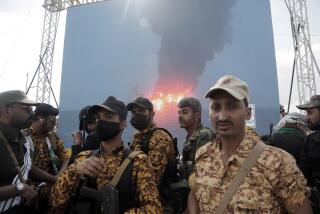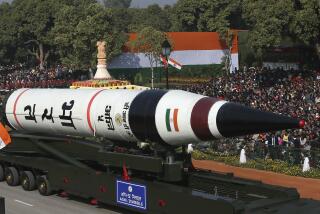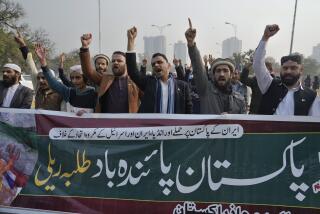India Says It Shot Down Spy Plane
NEW DELHI — India’s army said Sunday that it shot down an aircraft belonging to Pakistan that was spying in Indian airspace over the disputed territory of Kashmir, the hot spot in the simmering conflict between the two countries.
The reconnaissance plane, which India claimed had flown just inside the western Poonch district of Jammu and Kashmir state, crashed in Pakistan after Indian forces fired on it about 3:30 p.m. Sunday, India’s military said.
“It was an unarmed aerial vehicle which intruded in Poonch sector,” said an army source in Poonch who spoke on condition that he not be identified because government officials had not formally responded to the incident.
“It was spotted and engaged, and when the engagement took place, it was on its way back [to Pakistan],” the source added. “Whether it was shot down or hit, the Pakistanis will tell you.”
There was no formal response from Pakistan on Sunday night.
Some reports said the drone had penetrated two to four miles into Indian territory. But the military source in Poonch, who said he had visited the hilly border area immediately after the shooting, insisted that the aircraft had not come more than half a mile into Indian territory.
Not long before the drone was shot down, another unmanned Pakistani reconnaissance aircraft had entered Indian airspace in the same area, Farooq Abdullah, chief minister of Jammu and Kashmir state, claimed on Indian television.
India and Pakistan have hundreds of thousands of soldiers facing one another across the border and along a cease-fire line in Kashmir, in their biggest military standoff in more than a decade.
With these troops engaging in daily, though limited, clashes, the downing of the reconnaissance craft is likely to ratchet up tensions another notch just as there were signs that the atmosphere was easing slightly.
It is not common for unmanned aircraft to penetrate Indian airspace along the front with Pakistan, said Col. Shruti Kant, an Indian military spokesman.
“These are used for spying only,” Kant said in an interview. “But to the best of my knowledge, it is not a very usual thing there.”
According to an Indian TV report that Kant could not confirm, the Pakistani drone was flying very low, apparently photographing troop positions, and hovered over Indian territory for 15 to 20 minutes. But the military source in Poonch denied that the plane had been in Indian airspace that long.
The two armies traded heavy mortar and machine-gun fire after the drone was shot, the television report added.
India began a massive military buildup and threatened to attack Pakistan after five gunmen attacked the Indian Parliament on Dec. 13. The gunmen and nine other people died in the assault.
India blamed two Kashmiri separatist groups based in Pakistan. Pakistan’s president, Gen. Pervez Musharraf, condemned the attack and has since rounded up several hundred suspected extremists, but India says more must be done before talks can begin to defuse the crisis.
The drone incident is likely to feed anger in India just as the U.S., Britain and other foreign governments are trying to persuade the two nuclear powers to start talking and cool off a confrontation that threatens to erupt into war.
Just as Musharraf has to stand tough to avoid appearing to cave in to Indian threats, Indian Prime Minister Atal Behari Vajpayee has an eye on a looming election in the strategic northern state of Uttar Pradesh, where his Hindu nationalist Bharatiya Janata Party is in trouble in public opinion polls.
Both sides have said repeatedly that they do not want a larger conflict and have insisted that one isn’t likely to break out. But their forces are on high alert, with medium-range missile batteries at the ready and fighter jets on standby.
Earlier Sunday, Vajpayee and Musharraf chatted for about five minutes in Katmandu, Nepal, where they were attending a summit of South Asian leaders. But the two men later offered conflicting versions of what significance, if any, the brief encounter had.
Musharraf described it as “an informal interaction.”
“We only hope that this informal interaction will lead to a formal interaction in the future,” he said before leaving Katmandu.
When Vajpayee returned to New Delhi, he dismissed the chat.
“This was just a courtesy call,” he said. “Not much was discussed.”
On Saturday, Musharraf had tried to break the ice between Pakistan and India by striding across the stage after addressing the summit to shake Vajpayee’s hand.
Looking annoyed, and then slightly amused, the Indian premier went along with the gesture but then gave Musharraf the cold shoulder as the Pakistani leader left the conference’s opening ceremony.
“I was not disappointed at all,” Musharraf told reporters Sunday. “Unfortunately, an embrace was not possible because there was a big table in between us. But when I moved toward him, he did stand up, and he shook hands quite warmly.”
Musharraf said a peaceful resolution of the crisis must come in two steps.
“We must remove the dangerous tensions, [the] standoff existing between India and Pakistan,” the Pakistani leader said. “This is in the immediate context. And in a longer-term context, we need to address the main disputes--all disputes--confronting India and Pakistan to settle them in an amicable manner.”
The two countries’ foreign ministries did exchange documents Sunday, but details of the exchange were not made public.
*
Siddartha Barua of The Times’ New Delhi Bureau contributed to this report.
More to Read
Sign up for Essential California
The most important California stories and recommendations in your inbox every morning.
You may occasionally receive promotional content from the Los Angeles Times.










